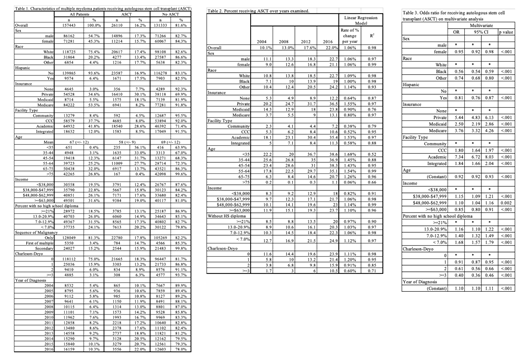INTRODUCTION: The prognosis of multiple myeloma (MM) has improved drastically in the last 20 years with the advent of novel agents, specifically with the introduction of bortezomib in late 2003. Novel agents in combination with autologous stem cell transplant (ASCT), have led to the achievement of high response rates in many patients. ASCT is now considered standard of care for all eligible patients, and previous studies have found increasing rates of ASCT in all age groups since the introduction of novel agents. Studies have also revealed disparities with decreased ASCT utilization in racial and socioeconomic minorities. This study utilizes the National Cancer Database (NCDB) to determine how the use of ASCT has changed for MM in the bortezomib era.
METHODS:The NCDB was used to identify 157,443 patients diagnosed between 2004-2016 with Multiple Myeloma. Only patients with information on ASCT were included, and demographic characteristics between those patients that received and did not receive ASCT were compared. Race, insurance type, facility type, average income, education, and Charleson-Deyo comorbidity score, among other factors, were included in this analysis (Table 1). To determine the trends in ASCT over the era of novel agents, the proportion of patients receiving ASCT within these groups was trended over each year, and linear models to determine the rate of change in each group was compared. Bivariate and Multivariate regression analysis for each characteristic was used to determines odds ratios (OR) for receiving ASCT by demographic factors.
RESULTS: Between 2004 to 2016 the proportion of all patients receiving ASCT as part of initial therapy more than doubled from 10.1% to 22.0%; increasing by approximately 1.06% per year on a linear regression model (R20.98) (Table 2). The greatest proportional increases were seen in Blacks, Hispanics, patients over 65 years of age, patients with higher comorbidity scores, Medicare, and patients treated at community centers. On multivariate analysis the patients that were most likely to receive ASCT (p<0.05) had private insurance (OR 5.4), were treated at academic centers (OR 7.3) and were highly educated (OR 1.7) (Table 3). For each increased year of diagnosis patients were significantly more likely (OR 1.1) to receive ASCT. Patients with a decreased chance of receiving transplant (p<0.05) were black (OR 0.6) or other non-white race (OR 0.7), Hispanic (OR 0.8), or had increased comorbidities (OR 0.4 for Charleson-Deyo score of 3 or greater). For every year of increased age, the likelihood of ASCT decreased (OR 0.92) (Table 3).
DISCUSSION: In the era of novel agents, the rate of ASCT has rapidly increased each year, with the greatest increases seen in elderly patients, those with higher comorbidity indexes, and in patients who are racially and socioeconomically disadvantaged. However, significant racial and socioeconomic disparities still exist in the treatment of MM, and must be considered as treatment continues to advance.
No relevant conflicts of interest to declare.
Author notes
Asterisk with author names denotes non-ASH members.


This feature is available to Subscribers Only
Sign In or Create an Account Close Modal